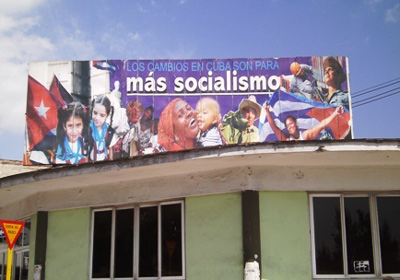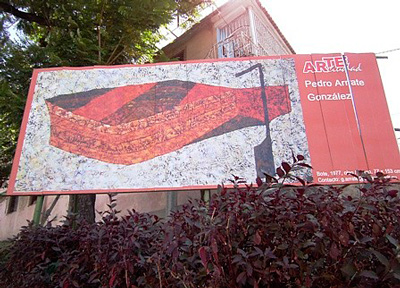Politics and Art: The Billboards of Santiago de Cuba
Fotorreportaje por Janis Hernández

HAVANA TIMES — Political propaganda has been accompanying Cubans lives since 1959. Every street, every town, every city, every province, the entire country is covered with signs bearing slogans, with billboards showing the images of government leaders, photographs of revolutionary martyrs, emblems and political jargon.
At the side of the road, over streets and avenues, at public spaces, on buildings, in parks: the entire island is flooded by slogans and icons that appear to remind us the way things work around here.
“Socialism or Death!”, “Freedom for the Five!”, “Ever Onward to Victory!” and a million other similar statements appear to follow us everywhere.

Many a time, I can’t help but feel a little like the character in George Orwell’s novel, when he felt that the enormous sign posted everywhere seemed to stare at him from all angles, burning the phrase above it into his mind: “Big Brother is Watching You.”
Luckily, someone had the idea of creating a project titled Arteciudad, which consisted in setting up large, urban billboards with the works of local artists and information about the artist and their work. The idea was to turn Santiago de Cuba into a vast, outdoor gallery.
Of course, this is not the only type of billboard one comes across in the city. Many of the ones set up are found at the entrance to clinics and hospitals, or at street corners, next to a stop sign, offering us a visual balance that passersby are enormously grateful for.
Below we offer you a series of images showing the signs that saturate our city, alternating between the political and the artistic.
Texto: Dariela Aquique
Click on the thumbnails below to view all the photos in this gallery. On your PC or laptop, you can use the directional arrows on the keyboard to move within the gallery. On cell phones use the keys on the screen.


















Predictably, you misquoted Jefferson. The correct quotation is:
“The tree of liberty must be refreshed from time to time with the blood of patriots and tyrants.”
There seems to be a large number of falsehoods, misquotations and errors you have gone through life believing are true. Have any of your students ever sued you for malpractice?
http://wiki.monticello.org/mediawiki/index.php/The_tree_of_liberty…
Here in Vermont, these ugly advertising billboards are illegal! What a contrast with the ugly clutter just across the river, in New Hampshire, and just about every other state in America. OTOH, at least some of the billboards depicted above, unlike the many ugly advertisements which clutter our highways, have artistic integrity and are pleasing to, or at least challenge, the aesthetic taste of the viewer. Some seem to bring art to wider public venues (instead of restricting it to the claustrophobic confines of museums, or even more inaccessible confines of the walls of the homes of wealthy patrons.
OTOH, slogans, pledges and bill-boards do loose their effectiveness over time. From 1789 through 1794, for example, most Frenchmen and Frenchwomen really took to heart the lyrics of Le Marseillaise, just as at one time most Americans took to heart our Pledge of Allegiance. Now–except for the rubes–it is but empty rhetoric! As Jeffersons says, the Tree of Liberty needs to be refreshed with the blood of Revolution with each generation; otherwise, it just ossifies.
Perhaps the propaganda billboards were effective in the early years of the Revolution. They have the effect of shouting down all contrary ideas and making the direction of the Revolution seem inevitable. Eventually, people go along with it anyway.
Over time, the value and effect of these posters diminishes, but to take them down would be to admit they don’t work anymore, and by extension, the ideas they promote don’t work anymore. The octogenarian rulers are not known for either self-reflection or innovative thinking. They will go on doing things as they have always done for half a century now.
I don’t know about all Canadian tourists, but this one found the signs creepy and pathetic.
There is a big difference between an electronic billboard selling sexy underwear or sugary soft drinks and an ugly paper billboard promoting an idealism proven to be a failure. You can choose which undies you buy and only you (ok, maybe not just you) will know if the billboards work. If you don’t think like the Castros tell you to think with their billboards, it could cost you your job, you access to university, even your freedom.
Do you think that the advertising billboards, the neon signs of the endless fast food restaurants and on and on, that we outside Cuba must endure, are not propaganda? We are innundated with the propaganda of consumerism from the moment we open our eyes until we go to bed.
Throughout the SF Bay Area where I live, the major thoroughfares and freeways are dotted with billboards for every manner of product on the market. I have to admit that the Burger King burgers on these billboards look delicious and when I am just a little hungry they serve to almost convince me to pull into a BK to buy one of these 1,500 calorie artery-clogging sandwiches. Here’s my question: As far as I have observed, not one of my close Cuban friends believes these political billboards has any effect on their political consciousness. I am especially perplexed why the boulevard leading from Jose Marti airport is cluttered with these billboards. Do the Castros think that they can convince visiting Canadians as well?